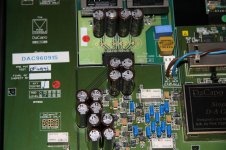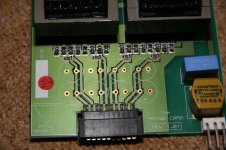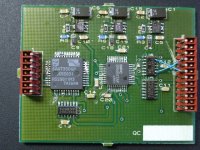Hi Guys,
I have to be very brief I’m afraid as I’m crazy busy with products going to production and an Inbox of over 600 Emails…
The 24Bit filter was designed after I left PT – I had no input on the design. A couple of years back I bought a Dacapo / DC from EBay – which had a 24 Bit filter fitted – first time I listen to it.
While it had “firmer more pronounced Bass” over the HDCD filter, it had a narrower sound stage and “brighter” more digital upper end.
Later I got to measure the filter and found very bad “Digital distortion products” – typical of rounding errors – it turns out that whoever designed the filter module had not enabled the digital filters “internal dithering function” to handle its truncation errors.
Maybe PT realised there error and correct on later filters (this may help explain the difference between the two 24bit filters).
My experience of Low ESR capacitors while having a very detailed sound can also sound very clinical and “Bass light”
I’ve had good results in the past with a “standard” Phillips capacitor range – but I don’t recall the series now.
Again, sorry for the brief reply,
JohnW
I have to be very brief I’m afraid as I’m crazy busy with products going to production and an Inbox of over 600 Emails…
The 24Bit filter was designed after I left PT – I had no input on the design. A couple of years back I bought a Dacapo / DC from EBay – which had a 24 Bit filter fitted – first time I listen to it.
While it had “firmer more pronounced Bass” over the HDCD filter, it had a narrower sound stage and “brighter” more digital upper end.
Later I got to measure the filter and found very bad “Digital distortion products” – typical of rounding errors – it turns out that whoever designed the filter module had not enabled the digital filters “internal dithering function” to handle its truncation errors.
Maybe PT realised there error and correct on later filters (this may help explain the difference between the two 24bit filters).
My experience of Low ESR capacitors while having a very detailed sound can also sound very clinical and “Bass light”
I’ve had good results in the past with a “standard” Phillips capacitor range – but I don’t recall the series now.
Again, sorry for the brief reply,
JohnW
Thanks for that John.
Here's a photo of THIS 24 bit filter, hope there's not a problem with it being shown? It is 10 years old now.
It does look rather modified!
I'll see if I can make enough sence of the data sheet to determine if any of those modification looking changes enable the “internal dithering function”.
Here's a photo of THIS 24 bit filter, hope there's not a problem with it being shown? It is 10 years old now.
It does look rather modified!
I'll see if I can make enough sence of the data sheet to determine if any of those modification looking changes enable the “internal dithering function”.
Attachments
Last edited:
The caps from my CD player have also been removed . Luckily there is no sign of leaking caps at all
Yes there is. Many of them have started leaking and eating into the gold pads. Those faint rings from the base of the capacitors are the liquid residue.
You need to clean that off.
please tell me more about polar or non-polar type of cap for replacement, aswell as parallel the caps: -negative (-) polar with (-) polar and positive with positive? Am I right?
What kind of the leaking caps are? Polar or Non-polar? Can I use either of them to replace the leaking caps?
Non-polarised capacitors have no polarity and do not have the -ve stripe down one side. They can be connected either way around.
The leaking ones are polarised capacitors. Polarised capacitors can explode if connected the wrong way around.
which caps please help
Hi Ianas
Thank for your advice. I did search google for more inf about how to replace a cap. Now I know abit about caps.
But I would like to hear from other members who did replace the caps successfully ( no master what the cap is)
Which one:
Rubycon ZLH or ZL
Cerafine
Oscons
Black Gates
Aerovox
Panasonic FC
Nichicon KZ
I also found that there is Panasonic cap
http://uk.farnell.com/panasonic/eeufm1e222l/capacitor-radial-2200uf-25v/dp/1219472
http://uk.farnell.com/panasonic/eeufm1e222l/capacitor-radial-2200uf-25v/dp/1219472
with ripple current at 3750mA and imp 0.012 ohm. According to the data, it is a bit better than Rubycon ZLH and ZL????? Is it true?
Ianas : which caps did you use actually to replace for Dacapo?
Hi Ianas
Thank for your advice. I did search google for more inf about how to replace a cap. Now I know abit about caps.
But I would like to hear from other members who did replace the caps successfully ( no master what the cap is)
Which one:
Rubycon ZLH or ZL
Cerafine
Oscons
Black Gates
Aerovox
Panasonic FC
Nichicon KZ
I also found that there is Panasonic cap
http://uk.farnell.com/panasonic/eeufm1e222l/capacitor-radial-2200uf-25v/dp/1219472
http://uk.farnell.com/panasonic/eeufm1e222l/capacitor-radial-2200uf-25v/dp/1219472
with ripple current at 3750mA and imp 0.012 ohm. According to the data, it is a bit better than Rubycon ZLH and ZL????? Is it true?
Ianas : which caps did you use actually to replace for Dacapo?
Which one:
Rubycon ZLH or ZL
Cerafine
Oscons
Oscon Conductive Polymer
Black Gates
Aerovox
Nichicon KZ
Nichicon Conductive Polymer
Panasonic FC
Panasonic ECA series Audio grade(Panasonics blub on these ECA: High Quality Audio Grade. High Fidelity. Low Distortion. High Resolution. Low Range Loudness.
For improved sound quality they feature a special electrolyte and vibration controlled outer Sleeve.)
Ianas : which caps did you use actually to replace for Dacapo?
I used Rubycon ZL as they were
cheap,
available,
recommended by several people inc in this thread,
sold by some on-line HiFi shops for an inflated price as 'excellent caps, similar sounding to Black Gates'. (Similar to Black Gates! Yeah right! Similar colour and made by Rubycon!)
I think it probably doesn't matter all that much in this circumstance which 'ordinary' caps are used. We're not asking them to deliver current. The main thing to get better sound quality seems to be to parallel some 'special' ones across them.
Unless your disposable wealth level permits exclusive use of 'special' ones, eg, Black Gates. Conductive Polymer caps appear to be in this category, but I'm currently unsure of their effect at bass and they only come smallish values.
10 years ago, with a friend we used to make and sell PSUs for CD players. We used 1000uF Nichicon KZ series before the discrete regulator(s) and Black Gate standard series in and after. I didn't use then in this DaCapo due to them being so very much larger for the capacitance. And also to save money, it was not known whether the white noise problem could be cured so there was no point in investing a larger sum only for it to be wasted.
They seem to be quite good, nice to listen to, by very laid back compared to Black Gates. The KZ's can cause a boomy bass when paralleled across a 10,000uF. Black gates = slam propelled by amazing dynamic range and speed at all frequencies, both on their own or paralleled across something larger.
The other thing to bear in mind is that the bridge diodes in the DaCapo are not all that beefy, and the transformers aren't either. Might be wrong with this one as I've not tired it, but all previous experience suggests that a very good separate PSU can't fail to improve this DAC.
The one I used on my 7350 DAC, with only drew 100mA, had 20,000 of the Nichicon KZ, discrete reg.'s, 1200uF black gate, 1000uf OsCon. For and output of ±15V DC. I'd have used ONLY Black Gates though if I could have justified the cost as my pals supply, equal in all ways except Black Gates instead on KZ's was Sooo much more 'powerful' and slam bam wallop!
Yes, it is floating. I've just checked.
Thanks for that
I'm only guessing but it rather seems that who ever populated that board mistakenly soldered the last floating pin of the 7350 instead of the last floating pin of the 5847!
I'll put that right. And have a listen before and after.
Another way that this assembly might be lacking is that the three 317's are fed direct from the +16V rail that feeds the +5V TO220, whereas all the other (digital) 317's are fed from the 8.2V regulator, thereby double regulating.
I've found in the past that double regulating with decoupling in between in a CD player can make a (surprisingly!) large improvement to the sound.
I guess one of the chips in one of the filter variants must have needed a higher voltage?
Thanks for that
I'm only guessing but it rather seems that who ever populated that board mistakenly soldered the last floating pin of the 7350 instead of the last floating pin of the 5847!
I'll put that right. And have a listen before and after.
Another way that this assembly might be lacking is that the three 317's are fed direct from the +16V rail that feeds the +5V TO220, whereas all the other (digital) 317's are fed from the 8.2V regulator, thereby double regulating.
I've found in the past that double regulating with decoupling in between in a CD player can make a (surprisingly!) large improvement to the sound.
I guess one of the chips in one of the filter variants must have needed a higher voltage?
Hi,
I am not sure about the trade-mark name of amps or DACs John W will be with. However, I did find the first Pink Triangle amp 2009 reviewed at:
http://hometheaterreview.com/pink-triangle-inergral-integrated-amp-reviewed/
mine
I mentioned this to an ex PT person and they said only 14 of these were ever made before the company folded.
Russ
Hi Guys,
I have to be very brief I’m afraid as I’m crazy busy with products going to production...
Did someone say production?
Hi muz640,
The A******* Dac is at final prototype stage - going to T0 (which means a small Qty. built by engineering deptment) - then to PP and then to full production - the process takes about 2 months.
John
If you want to send me one for evaluation purposes that would be great
Its possibly the most eagerly anticipated Dac in the history of the world!
I think i can wait two months, ive got my stopgap (new) Dacmagic, thats been holding its own. It will be interesting to compare eventually! (i feel if i have to wait any longer my ear hair will have grown so long i wont be able to hear anything anyway
Last edited:
The A******* Dac is at final prototype stage - going to T0 (which means a small Qty. built by engineering deptment) - then to PP and then to full production - the process takes about 2 months
John, just asking out of curiosity, has it already had listening testing and refinement or does that happen at this stage? I was talking to someone from another company a few months ago and he said they did none! The product went from the drawing board to the shops. They knew nothing about running in capacitors before listening to their effect! It could have been though that that man just didn't fully know what went on there during the prototyping. I'd be interested in knowing what you choice of capacitors are these days. These Nichicon conductive polymers I fitted to this DaCapo really do seem to clean up and bring together the upper parts of the sounds. So far, two weeks in, bass seems to be a bit quiet though. It would be intersting to know if the Sanyo OsCon, and others, sound any different to these.
IIRC did you mention that there are no chip Op-Amps? So therefore no problem choosing which one sounds best (or is that 'sounds least bad')
Are you missing out ALL the copper track in the analogue stage as to my ears copper track sounds veiled, blurry, dull, muddled? In the old 7350 DAC I was using, just missing out 20mm of it and joining the resistors and capacitors from chip pin to chip pin was a not difficult to tell audible improvement
Can you re-shape this new DAC into an 8 channel version preceded by what ever is used to decode / translate home theatre audio so we can at last have the same quality for the rear (and centre) speakers when watching / hearing a film / TV in DD / DTS, or the new even better HD DD / DTS, as we do when listening to some music without pictures? A 4 channel version would do for my use as I don't use a centre or sub.
Cheers,
Ian
Last edited:
I have another few improvements for the DaCapo.
• Add a Nichicon Conductive Polymer capacitor, 820µF 6.3V, going +5V to ground, after each of the last two LM317 regulators (nearest to the DAC can) (one cap for each of left and right channel) that feed the logic chips in the DAC can. Even though in there are already five 22uF Tant chip caps each with a 0.1µF chip cap, each pair decoupling each of the 5 chips per channel, the 820µF improves the upper end of the sound, bringing it together and reducing a kind of splashyness / glare. Further reducing the veil. NOTE: Before doing this, I first added a back (protection) diode across each of these 4 regulators, as stated as a requirement in the LM317 data sheet.
• Add a 0.1µF poly prop cap across the ± supply pins of each of the two OPA604 output OpAmps. I plan to increase this to 0.3µ to see if that's even better.
• I then added a black gate to each of the 820µ caps and that was a further refinement and also filled out the bass, as they often do.
• We tried different mains leads, all ones we made ourselves, all differing in resistance, capacitance and inductance. All sounded very different. One gave a much larger bass than the others which brought forward the bottom area nicely as there was far too little as it was. So you can count suitable mains cable selection as an improvement too.
• Add a Nichicon Conductive Polymer capacitor, 820µF 6.3V, going +5V to ground, after each of the last two LM317 regulators (nearest to the DAC can) (one cap for each of left and right channel) that feed the logic chips in the DAC can. Even though in there are already five 22uF Tant chip caps each with a 0.1µF chip cap, each pair decoupling each of the 5 chips per channel, the 820µF improves the upper end of the sound, bringing it together and reducing a kind of splashyness / glare. Further reducing the veil. NOTE: Before doing this, I first added a back (protection) diode across each of these 4 regulators, as stated as a requirement in the LM317 data sheet.
• Add a 0.1µF poly prop cap across the ± supply pins of each of the two OPA604 output OpAmps. I plan to increase this to 0.3µ to see if that's even better.
• I then added a black gate to each of the 820µ caps and that was a further refinement and also filled out the bass, as they often do.
• We tried different mains leads, all ones we made ourselves, all differing in resistance, capacitance and inductance. All sounded very different. One gave a much larger bass than the others which brought forward the bottom area nicely as there was far too little as it was. So you can count suitable mains cable selection as an improvement too.
Last edited:
Hi JohnW, R U and the new dac OK?
When all this started I had a newborn cat. Now I guess my cat is bigger than your dog )
)
I see that sometimes you take a look at this thread, that's becoming a thread about the sex of the caps
I'd like to tell you this:
if you definitely abandoned the project of repairing my da capo board ( with his new made traks and new caps :-( sigh, sigh )
if you don't need them for “electronic surgery”
if you don't need them for whatever reason
if you find them
if you have the time to do it
could you please send back the hdcd and 18bit filters anf the clock lock dic at my expense,
so I can have my cardinal/ordinal (now I have 2 ordinals) at theyr best while I wait for your new dac?
Since your FIFO mailbox will probably never be emptied, if you mail me I can answer by sms of by fax.
Thanx
Loris
ps would it be difficult to put the ordinal into the cardinal? I guess I'd need a connection cable, an on/off cable and a power/on one..........
When all this started I had a newborn cat. Now I guess my cat is bigger than your dog
I see that sometimes you take a look at this thread, that's becoming a thread about the sex of the caps
I'd like to tell you this:
if you definitely abandoned the project of repairing my da capo board ( with his new made traks and new caps :-( sigh, sigh )
if you don't need them for “electronic surgery”
if you don't need them for whatever reason
if you find them
if you have the time to do it
could you please send back the hdcd and 18bit filters anf the clock lock dic at my expense,
so I can have my cardinal/ordinal (now I have 2 ordinals) at theyr best while I wait for your new dac?
Since your FIFO mailbox will probably never be emptied, if you mail me I can answer by sms of by fax.
Thanx
Loris
ps would it be difficult to put the ordinal into the cardinal? I guess I'd need a connection cable, an on/off cable and a power/on one..........
Big problem must be seen. Need your help. Please
Hi,
Please help me to give your advice about replacing capacitors for Dacapo DAC
Please look at the photo: this is the original condition of capacitors before being removed out of the board.

According to the photo of the capacitors( capacitor 1,2,3,4) you can see the polary as : (- +) , (- +) , (+ -) , (- +)
And the photo of the board after removing capacitors:
You can the board printed as: (- +) , ( + -) , ( + -) , ( - +)

I think the capacitor number 2 was inserted INCORRECTLY by manufactory. However, my DAC did work perfectly.
Now the old-leaking capacitors must be replaced. I do not know which way to go:
1- Accept the mistake of manufactory ( replace exactly as photo)
2- Go as the board print : (- +) , ( + -) , ( + -) , ( - +)

Dacapo’s owners, I highly appreciate if you could open your Dacapo and give me your advice

Julio
Hi,
Please help me to give your advice about replacing capacitors for Dacapo DAC
Please look at the photo: this is the original condition of capacitors before being removed out of the board.

According to the photo of the capacitors( capacitor 1,2,3,4) you can see the polary as : (- +) , (- +) , (+ -) , (- +)
And the photo of the board after removing capacitors:
You can the board printed as: (- +) , ( + -) , ( + -) , ( - +)

I think the capacitor number 2 was inserted INCORRECTLY by manufactory. However, my DAC did work perfectly.
Now the old-leaking capacitors must be replaced. I do not know which way to go:
1- Accept the mistake of manufactory ( replace exactly as photo)
2- Go as the board print : (- +) , ( + -) , ( + -) , ( - +)

Dacapo’s owners, I highly appreciate if you could open your Dacapo and give me your advice
Julio
- Home
- Source & Line
- Digital Line Level
- Da-capo issue (John W?)


